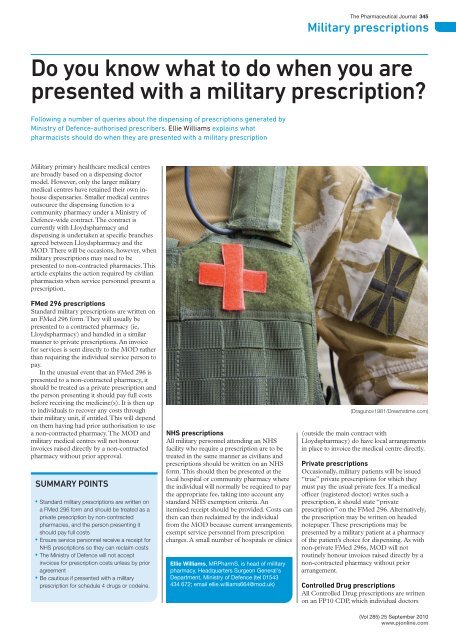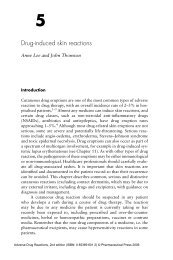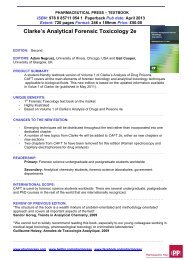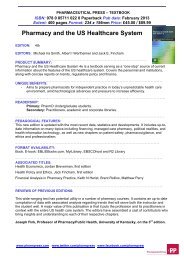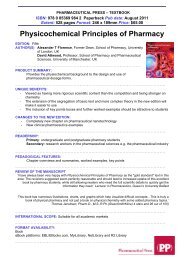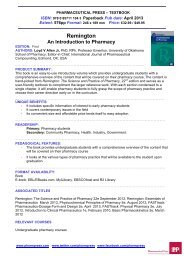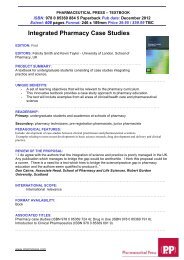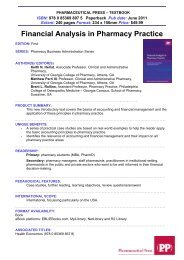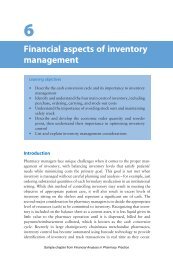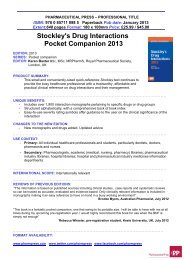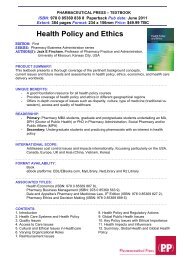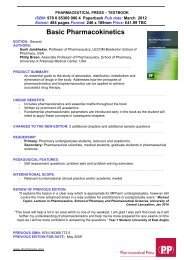How to deal with military prescriptions - Pharmaceutical Press
How to deal with military prescriptions - Pharmaceutical Press
How to deal with military prescriptions - Pharmaceutical Press
You also want an ePaper? Increase the reach of your titles
YUMPU automatically turns print PDFs into web optimized ePapers that Google loves.
The <strong>Pharmaceutical</strong> Journal 345<br />
Military <strong>prescriptions</strong><br />
Do you know what <strong>to</strong> do when you are<br />
presented <strong>with</strong> a <strong>military</strong> prescription?<br />
Following a number of queries about the dispensing of <strong>prescriptions</strong> generated by<br />
Ministry of Defence-authorised prescribers, Ellie Williams explains what<br />
pharmacists should do when they are presented <strong>with</strong> a <strong>military</strong> prescription<br />
Military primary healthcare medical centres<br />
are broadly based on a dispensing doc<strong>to</strong>r<br />
model. <strong>How</strong>ever, only the larger <strong>military</strong><br />
medical centres have retained their own inhouse<br />
dispensaries. Smaller medical centres<br />
outsource the dispensing function <strong>to</strong> a<br />
community pharmacy under a Ministry of<br />
Defence-wide contract. The contract is<br />
currently <strong>with</strong> Lloydspharmacy and<br />
dispensing is undertaken at specific branches<br />
agreed between Lloydspharmacy and the<br />
MOD. There will be occasions, however, when<br />
<strong>military</strong> <strong>prescriptions</strong> may need <strong>to</strong> be<br />
presented <strong>to</strong> non-contracted pharmacies. This<br />
article explains the action required by civilian<br />
pharmacists when service personnel present a<br />
prescription.<br />
FMed 296 <strong>prescriptions</strong><br />
Standard <strong>military</strong> <strong>prescriptions</strong> are written on<br />
an FMed 296 form. They will usually be<br />
presented <strong>to</strong> a contracted pharmacy (ie,<br />
Lloydspharmacy) and handled in a similar<br />
manner <strong>to</strong> private <strong>prescriptions</strong>. An invoice<br />
for services is sent directly <strong>to</strong> the MOD rather<br />
than requiring the individual service person <strong>to</strong><br />
pay.<br />
In the unusual event that an FMed 296 is<br />
presented <strong>to</strong> a non-contracted pharmacy, it<br />
should be treated as a private prescription and<br />
the person presenting it should pay full costs<br />
before receiving the medicine(s). It is then up<br />
<strong>to</strong> individuals <strong>to</strong> recover any costs through<br />
their <strong>military</strong> unit, if entitled. This will depend<br />
on them having had prior authorisation <strong>to</strong> use<br />
a non-contracted pharmacy. The MOD and<br />
<strong>military</strong> medical centres will not honour<br />
invoices raised directly by a non-contracted<br />
pharmacy <strong>with</strong>out prior approval.<br />
SUMMARY POINTS<br />
• Standard <strong>military</strong> <strong>prescriptions</strong> are written on<br />
a FMed 296 form and should be treated as a<br />
private prescription by non-contracted<br />
pharmacies, and the person presenting it<br />
should pay full costs<br />
• Ensure service personnel receive a receipt for<br />
NHS <strong>prescriptions</strong> so they can reclaim costs<br />
• The Ministry of Defence will not accept<br />
invoices for prescription costs unless by prior<br />
agreement<br />
• Be cautious if presented <strong>with</strong> a <strong>military</strong><br />
prescription for schedule 4 drugs or codeine.<br />
NHS <strong>prescriptions</strong><br />
All <strong>military</strong> personnel attending an NHS<br />
facility who require a prescription are <strong>to</strong> be<br />
treated in the same manner as civilians and<br />
<strong>prescriptions</strong> should be written on an NHS<br />
form. This should then be presented at the<br />
local hospital or community pharmacy where<br />
the individual will normally be required <strong>to</strong> pay<br />
the appropriate fee, taking in<strong>to</strong> account any<br />
standard NHS exemption criteria. An<br />
itemised receipt should be provided. Costs can<br />
then can then reclaimed by the individual<br />
from the MOD because current arrangements<br />
exempt service personnel from prescription<br />
charges. A small number of hospitals or clinics<br />
Ellie Williams, MRPharmS, is head of <strong>military</strong><br />
pharmacy, Headquarters Surgeon General's<br />
Department, Ministry of Defence (tel 01543<br />
434 672; email ellie.williams664@mod.uk)<br />
(Dragunov1981/Dreamstime.com)<br />
(outside the main contract <strong>with</strong><br />
Lloydspharmacy) do have local arrangements<br />
in place <strong>to</strong> invoice the medical centre directly.<br />
Private <strong>prescriptions</strong><br />
Occasionally, <strong>military</strong> patients will be issued<br />
“true” private <strong>prescriptions</strong> for which they<br />
must pay the usual private fees. If a medical<br />
officer (registered doc<strong>to</strong>r) writes such a<br />
prescription, it should state “private<br />
prescription” on the FMed 296. Alternatively,<br />
the prescription may be written on headed<br />
notepaper. These <strong>prescriptions</strong> may be<br />
presented by a <strong>military</strong> patient at a pharmacy<br />
of the patient’s choice for dispensing. As <strong>with</strong><br />
non-private FMed 296s, MOD will not<br />
routinely honour invoices raised directly by a<br />
non-contracted pharmacy <strong>with</strong>out prior<br />
arrangement.<br />
Controlled Drug <strong>prescriptions</strong><br />
All Controlled Drug <strong>prescriptions</strong> are written<br />
on an FP10 CDP, which individual doc<strong>to</strong>rs<br />
(Vol 285) 25 September 2010<br />
www.pjonline.com


